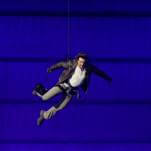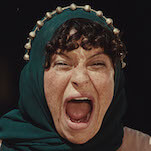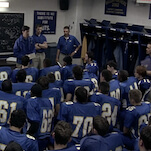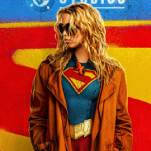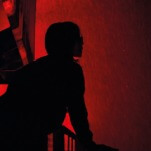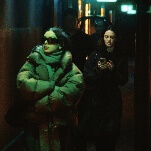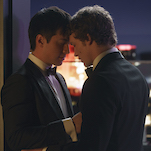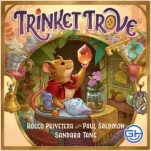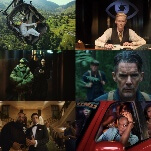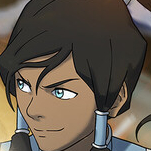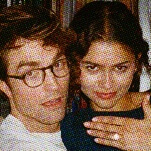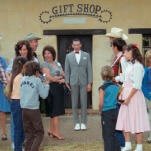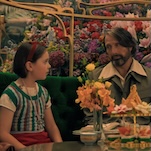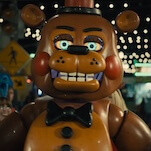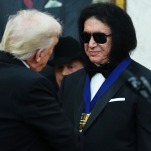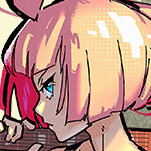Grades: Pleasures Of The Flesh: B+; Violence At Noon: A; Sing A Song Of Sex: B-; Japanese Summer: Double Suicide: C; Three Resurrected Drunkards: B
Though it would be reductive to draw too many comparisons between the French New Wave and the much looser association of filmmakers that comprised the Japanese New Wave, the two have a few fundamental things in common: an engagement with the social and political upheaval of the times, a wholesale rejection of tradition and the status quo, and a restless inclination to shake up the medium itself. Called the Japanese Jean-Luc Godard, Nagisa Oshima (In The Realm Of The Senses) pushed the studio system as far as it could go early in his career with movies like 1960’s Cruel Story Of Youth, his seminal sex-and-death provocation. But before long, his outré vision landed him in exile. When the assassination of Japan’s Socialist Party president by a right-wing nationalist coincided with the release of Night And Fog In Japan, Oshima’s harsh critique of the leftist establishment, the studio pulled it from theaters and the director departed as well.
The new Eclipse box set Oshima’s Outlaw Sixties includes five features the director produced through his independent company, Sozosha, during a prolific period between 1965 and 1968, when he was unbound by outside restrictions or commercial concerns. Seen in order, the films are a journey into abstraction, as the thin filament connecting Oshima to any kind of narrative convention is strained and finally cut altogether, and controlled chaos reigns. Making sense of Oshima’s increasingly absurdist ruminations on the culture, particularly the country’s troubled history with Korea and Korean immigrants, isn’t terribly easy for non-scholars, and his freewheeling style only exacerbates the problem. But this is filmmaking at its most liberated, charged by a rebellious spirit that can be appreciated even when it can’t be fully understood.
Kicking off with a playful shot to the bow, 1965’s Pleasures Of The Flesh was Oshima’s irreverent take on the so-called “pink films,” the softcore sexploitation fare that was emerging at the time. (It yielded some oddball gems of its own, like the 1974 cult item School Of The Holy Beast.) Blackmailed into stashing a suitcase full of embezzled cash while the embezzler serves time in prison, his lonely hero (Katsuo Nakamura) decides instead to blow the money on women and other indulgences, then commit suicide when he runs out. That may sound like the makings of a libidinous romp, but Oshima cleverly subverts the premise and the genre by making a film about repression and frustrated desire. Not exactly titillating.
By far the jewel of the set, 1966’s Violence At Noon features more than 2,000 cuts in 99 minutes; it takes a Cuisinart to the disturbing tale of a serial killer and rapist who’s protected by two unlikely women—his ex-wife and a former victim. Freely incorporating flashbacks into the killer’s ongoing activities, Oshima’s radically fragmented style makes sense of the complicated, seemingly inexplicable motives that would lead these women to shield a man who’s done so many terrible things. But the film’s formal audacity impresses the most, as Oshima fiddles with odd-kilter compositions, gorgeous flurries of imagery, and a playful chronology that anticipates directors like Nicolas Roeg and Richard Lester.
The other three films dive off the cliff’s edge entirely, and are more interesting conceptually than they are as a coherent experience unto themselves. On the heels of Violence At Noon, the placid beginnings of 1967’s Sing A Song Of Sex are downright square, as four high-school boys fantasize crudely about their female classmates and go drinking with their teacher, who turns up dead from a gas leak the next morning. Then the film ventures headlong into the absurd, centering on a bizarrely theatrical did-they-or-didn’t-they gang-rape sequence at the front of a classroom. It’s visually striking, but obscure, ending with a political monologue that seems shoehorned into place.
1967’s Japanese Summer: Double Suicide and 1968’s Three Resurrected Drunkards are more thoroughly perplexing, though in very different ways. The former opens with stunning exterior shots of a brazen sexpot questioning and disrupting various social rituals, but after she hooks up with a suicidal man and a would-be gangster, the film moves into an underground hideaway for most of its running time. It then becomes a strange, tedious sort of No Exit, with anarchists confined to one metaphorical space. Divining meaning from the equally inexplicable Three Resurrected Drunkards isn’t any less of a challenge, but the zany comic tone, established by the sped-up soundtrack and Hard Day’s Night-like hijinks of the opening sequence, gives it a lift. It’s insane, but the film’s anything-goes recklessness provides the set with a fitting capper.
Key features: Scholarly and extremely helpful liner notes by Michael Koresky.


